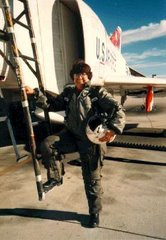It's funny about airplanes; we love them for the oddest reasons. Sometimes it's because they're just plain beautiful, sometimes it's because they're not. I don't just have one favorite, I've got a bunch. Favorite century-series fighter, favorite post-century-series fighter, favorite transport, favorite bomber, favorite recce plane, favorite lifting body, favorite carrier airplane, favorite Soviet airplane, favorite Antipodean airplane, favorite attack airplane, favorite X-plane, and so on.
My favorite "regular" post-century-series fighter airplane is the McAir F-4 Phantom II, with the McAir F-15 Eagle running it a close second. Both of these airplanes are definitely heavy metal. The F-4[1] is extremely resistant to battle damage and so, probably, is the F-15 (it just hasn't been in as much combat). There were F-4s in Vietnam that came home sucking fuel from a tanker because they'd been so shot up that their tanks couldn't hold enough fuel to keep the engines running. And there was an Israeli F-15 that lost almost all of one wing in a mid-air collision and still flew and landed safely. In fact, they replaced the wing and the airplane went back into regular use.
The F-4 has been called "the triumph of thrust over aerodynamics", among other things, and there's a kernel of truth in this description. It's excess thrust that made the F-4 such a successful airplane and such a favorite with pilots. It was possible to put a tremendous load on the F-4 and still fly reasonable distances. It could be decked with all sorts of munitions and have enough thrust to take off and fly with them. It was big and tough and, to quote one of my friends who flew them, "a real man's airplane". It looked like a kick-ass war plane.
I love F-4s. Getting a ride in one was one of the highlights of my life. I was lucky.
I still remember what must have been the last time I saw F-4s take off. We'd gone to Reno in mid-January to go to the AIAA Aerospace Sciences Conference because I was on the Atmospheric Flight Mechanics Technical Committee and we had a meeting every year at Aerospace Sciences. I was walking out to pick up the rental car and go back for my husband and the luggage and I heard the magic sound of four J79 engines spooling up. I looked over at the runway and there were two Nevada Air National Guard F-4s doing the last before-takeoff checks. They finished the checklist and, after a moment poised there in (probably) MIL power, they released the brakes and started rolling down the runway. Going faster and faster they rotated and lifted off gracefully, in a perfect formation takeoff, and flew away into the blue winter sky. It was just beautiful.
[1] This way of referring to an airplane, with the letter and number, is my habit because that's how we do it at NASA Dryden. We don't call airplanes by their names or, usually, by their nicknames. It's an F-4, not a Phantom or an Iron Rhino or Double Ugly or Old Smoky.
Subscribe to:
Post Comments (Atom)








No comments:
Post a Comment